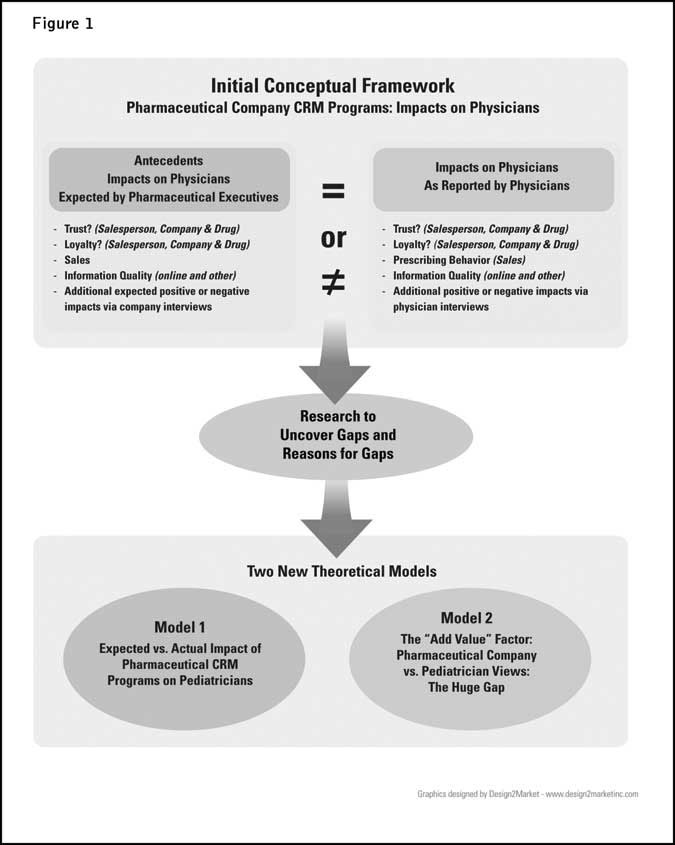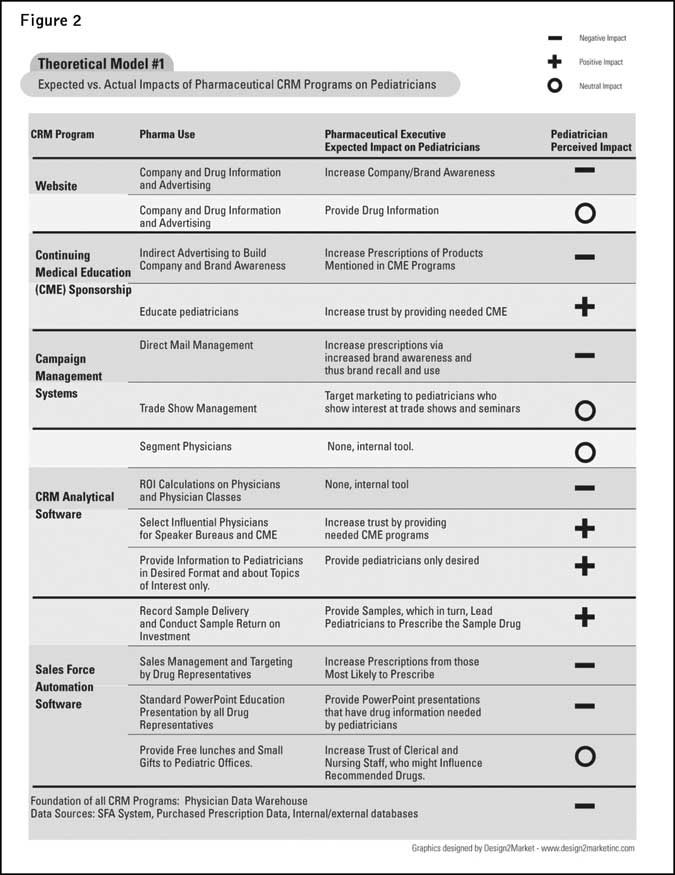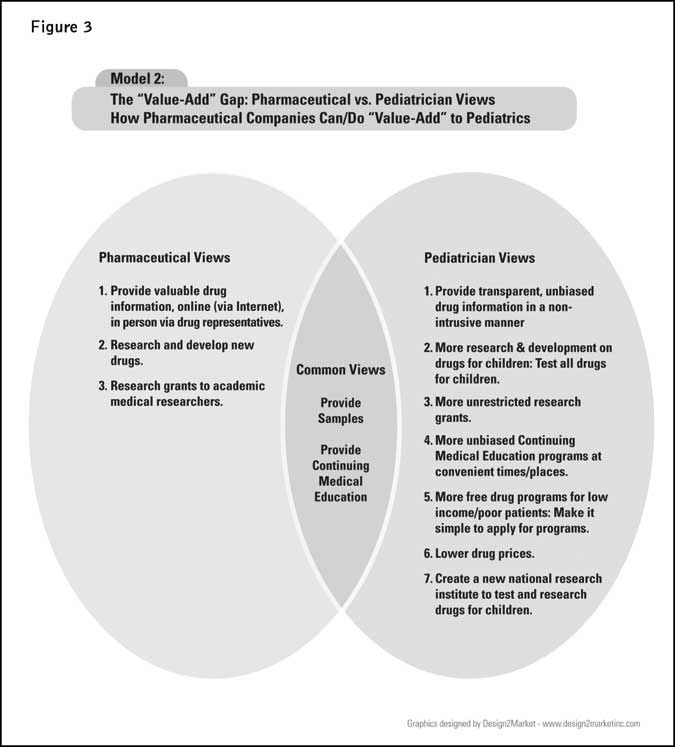This relationship needs more managing
Editor’s note: Mary Jean Koontz is CEO of Pacific Creations International, a San Francisco research firm.
Today’s pharmaceutical companies are in the midst of global transformation, many investigating how to develop greater trust among a subset of “platinum” physicians who, due to decreasing insurance payments, have increasingly limited time to learn about new and emerging drugs. Current pharmaceutical customer relationship management (CRM) and sales force automation (SFA) programs are being perfected to hopefully wield even greater influence on doctors and their prescribing habits.
But what is the actual impact of all of the CRM efforts on the physicians? Have the millions of dollars invested in pharma CRM and SFA systems had a positive impact in regards to increased trust with physicians?
The author conducted a national qualitative interview-based study of pharmaceutical managers and American pediatricians to determine the intended (pharmaceutical corporate side) impact of drug makers’ CRM programs on pediatricians vs. the actual impact, as determined via interviews with a cross-section of American pediatricians.
The research came to the conclusion that many of the CRM and SFA programs had a negative, or at best, neutral impact on doctors. However, physicians in management positions stated that CRM-based marketing likely influences them to prescribe more of a certain company’s medications.
Effectively divide up
CRM and SFA software allows pharmaceutical companies to effectively divide up doctors into profitable vs. unprofitable segments. Zeithaml (Zeithaml, 2001) developed the customer pyramid to show how a major pharmaceutical company segmented customers (physicians) into platinum, gold, iron and lead segments by “viewing physicians as long-term strategic assets” and thereafter targeted them based on potential profitability across the company’s drug portfolio (rather than on current sales within a single therapeutic category) (Zeithaml 2001).
Segmenting physicians according to their profitability requires a drug company to consolidate physician databases across business units. The pharmaceutical companies used the following inputs for their “physician profitability analysis”:
-
the volume of prescriptions a particular physician generated (via IMS Health data);
-
the value of prescriptions;
-
the cost of a sales call;
-
the cost of product samples;
-
product gross margins, rebates and discounts (Zeithaml 2001).
Research framework and methodology
The author’s research focused on pediatricians as a subset of physicians. The research framework is shown in Figure 1. The research was conducted in two major phases. In year one, the pharmaceutical executives were interviewed. In year two, the pediatricians were interviewed. 
Eight total in-person and telephone interviews were conducted with managers and executives at medium to large-scale pharmaceutical companies. They were recruited via industry contacts, followed up by written agreements between the researcher and manager not to mention the company name or the exact title of the pharmaceutical manager.
The focus of the interviews with the pharmaceutical managers was to learn the overall company/industry objectives of the CRM and SFA programs. Responses ranged from comments such as this one, from an executive, “That’s simple, our goals are to increase sales” to a lower-level manager, who explained in detail his efforts to further develop a repository of medical study articles that would eventually be served up to the relevant physicians.
Once the pharmaceutical management interviews were conducted, the researcher developed the physician discussion guide. Pediatricians were recruited via personal interactions at two national pediatric conferences. Due to the fact that the research was academic, not commercial, pediatricians were open to being contacted later for a telephone interview. Although the physician sample was small - 35 total - it included a national representation of private-practice, research and HMO pediatricians.
Analysis
Respondents were promised that their name and affiliation would be withheld from the final report. The interview digital .wav file was downloaded onto a computer and transcribed into a Word document. Pseudo first names were randomly selected for all participants. The researcher used ATLASti software for the thematic analysis of the pharmaceutical company interview data. The researcher developed over 50 codes, which were then assigned to the pharmaceutical company interview transcripts. The codes were then grouped into families or themes.
For the physician interviews, the researcher used SPSS software to conduct the analysis. Since SPSS allows for up to 250 characters in a quote, the researcher was able to create “quote” variables in SPSS. The researcher then used SPSS to sort and group the quotes according to various demographic and psychographic variables.
The majority of “perceived impacts” of pharmaceutical company CRM programs were either neutral or negative, although pediatricians did mention some positive impacts. The points below summarize the pediatricians’ perceived impacts of CRM programs.
Most prominent negative impacts
Non-transparent, unreliable information about drugs. Glossy advertising-type drug brochures and presentations lowered the already low level of trust between pediatricians and pharmaceutical companies.
Aggressive, insistent drug representatives who use SFA systems to “analyze and segment” physicians. This leads pediatricians to have an even lower level of trust in the drug representative.
Most prominent neutral impacts
Pharmaceutical company Web site. Most pediatricians do not visit pharmaceutical company Web sites as they are viewed as biased toward the company’s drugs.
E-detailing. Most pediatricians had no experience with e-detailing, expressing a neutral opinion of its impact on their medical practice.
Most prominent positive impacts
Continuing medical education (CME). Pediatricians view CME as having a positive impact on their medical practice, especially if the program is not biased towards one company’s drugs.
Drug samples. Pediatricians viewed the distribution of drug samples as having a positive impact on their medical practice, particularly for their lower-income patients.
Manipulative and pushy
CRM and SFA software programs allow pharmaceutical marketing and sales people to perform more aggressive and standardized marketing campaigns. From the pediatricians’ perspective, more aggressive marketing and sales is often seen as manipulative and pushy behavior.
This research concludes that the majority of interviewed pediatricians had a healthy distrust of pharmaceutical companies. While most pediatricians were not highly aware of the variety of CRM programs targeted at physicians, when they were made aware of the programs and their intended impact on physicians, the level of trust in pharmaceutical companies decreased.
The research also points to the conclusion that the majority of pediatricians do not trust the data in medical studies and papers provided by pharmaceutical companies. SFA and CRM programs allow drug representatives to deliver canned and company-approved research reports. The majority of pediatricians interviewed expressed concern that pharmaceutical research data does not include any negative findings; some even suggested studies that are showing negative results are stopped before completion.
Elizabeth, a young academic research pediatrician, accurately described the reasoning behind much of the lack of trust in pharmaceutical company research: “With regard to the research piece, I think the biggest problem is when there is a research project and the pharmaceutical company has control of the data and they have control of the manuscript. Since they have a vested interest in the financial outcome, it could influence the way the data is interpreted or presented. That, to me, drives the problem with trust.”
Even less trust
Pediatricians feel manipulated by the pharmaceutical companies; they don’t trust the marketing management to provide honest information about drugs. Furthermore, the advent of consumer prescription drug television advertising has led pediatricians to have even less trust in pharmaceutical companies. Pediatricians suggest that TV ads are misleading and deceptive, as illustrated by the following quote from Justin, a doctor in private practice: “Now it seems that most of the pharmaceutical companies spend more of their time and money marketing directly to the public, who are naive and don’t understand that these are people with profit motives, that the drugs on TV aren’t automatically much better just because they’re on TV. It makes patients think there’s a cure for their disease, there’s a better drug than they’re getting, that newer and more-advertised is better. Oftentimes, they’re not.”
Little knowledge
Pediatricians don’t trust that the average drug representative is knowledgeable about the products. With SFA-based “canned presentations,” the drug representative is thought to have little knowledge beyond what they’ve been “trained to say.” Furthermore, SFA-based systems set quotas for samples, visits and prescriptions, leading the average sales representative to become pushy and aggressive in getting physicians to prescribe their drugs so they can “meet their sales quotas” and make their much needed commissions.
One pediatrician said: “Drugs are the same product like a car or anything. Working on commission certainly creates problematic conflicts at times. When you’re buying a car, at least you’re buying it for yourself. When you buy a drug, or you prescribe a drug, it’s not for yourself, it’s used by someone else. If there are inappropriate incentives or pressure, it takes it to a different philosophical level.”
Pediatricians with 25 years or more experience spoke of how the knowledge level of the average sales representative has declined, adding that, with fewer career drug representatives, “it is more difficult than in prior years to develop trust over time.”
All of these factors have contributed to a general decline in trust between the drug representative and the pediatrician. While CRM and SFA tools allow drug representatives to efficiently target-market, the majority of pediatricians find it offensive to be the “target” of a marketing operation, when they are simply trying to help their patients maintain their health or recover from an illness.
Two models
The research resulted in two models, as shown in Figures 2 and 3. Model 1, which presents the expected vs. actual effects of CRM programs, shows that once aware of CRM-based physician targeting, pediatricians had negative opinions of nearly half of the CRM programs.


With their trust in pharmaceutical companies declining, what do the pediatricians really want from the pharmaceutical companies? The researcher asked company executives and pediatricians how the pharmaceutical makers can add value to a pediatric practice. Model 2 shows the vast differences between responses from the two parties.
The doctors’ wariness makes it clear that pharmaceutical companies must carefully consider how they incorporate the value-adding concepts mentioned by pediatricians into their customer relationship management programs. But one promising course of action would be to develop and publicize CRM and SFA programs that focus on the stated needs of the pediatric community, namely:
-
publish transparent unbiased medical study and drug information;
-
fund unrestricted medical education and research grants; and
-
educate physicians about drug representatives’ use of SFA tools (the majority of physicians said they would like to be able to view their own prescription history; this information resides in the typical SFA system).
Achieve the goal
While there are no guarantees, were pharmaceutical companies to implement the above measures - and others that take physicians’ needs and viewpoints into consideration - it is likely that physicians would increase their overall level of trust and enable the industry to achieve the previously-stated goal of its CRM programs: increased sales.
Reference
Zeithaml, V.A.; Rust, Roland T.; and Lemon, Katherine, N. (2001). “The Customer Pyramid: Creating and Serving Profitable Customers.” California Management Review 43(4): 118-142.
